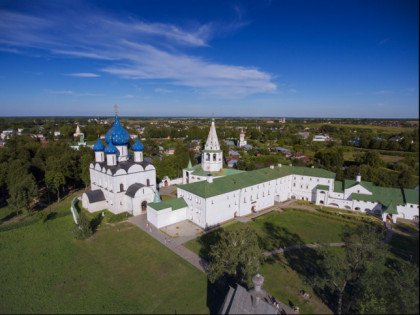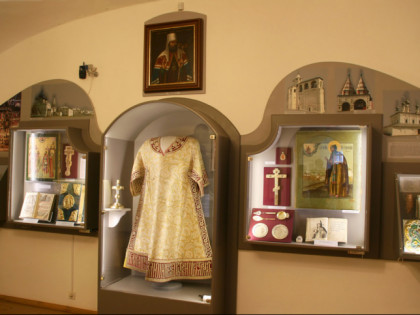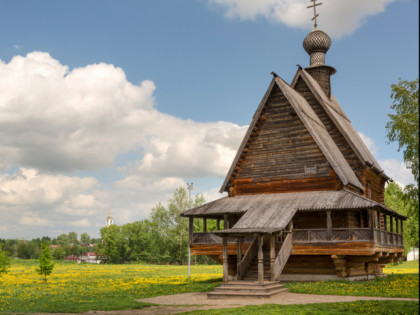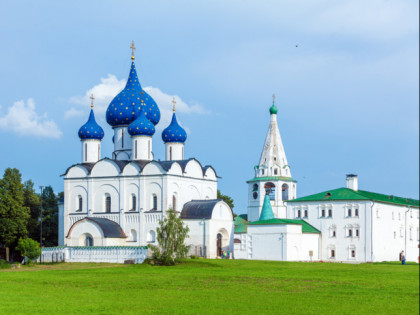Suzdal Kremlin: Treasures behind the Ancient Earth Ramparts
The Suzdal Kremlin is the main attraction of the town and its oldest part that exists since the 10th century. The fortress, which protected the prince's court and the cathedral, was surrounded by earth ramparts. And although not all buildings in the Kremlin have survived to this day, it is recognized as one of the most important monuments of Old Russian architecture and is named a UNESCO World Heritage Site.
The first building in the territory of the Suzdal Kremlin was the wooden Church of the Assumption. After its collapse, the Cathedral of the Nativity was built in this place in 1225. It was erected on a powerful foundation using a unique technology of bricks lined with limestone. The walls are decorated with a carved ornament and frescoes of the XVII century. The main attraction of the cathedral are the Golden Gates of the 13th century, covered with black copper plates with golden drawings themed on the Gospel. In the XIX century an original bowl for holy water in the form of a samovar appeared in the cathedral.Inside the walls of the Suzdal Kremlin, worth a look are the Bishops' Chambers. They appeared in the 15th century and acquired a modern look in the late 17th century. Eye-catching is the ceremonial Chamber of the Chrism with nine-meter arches without pillars. The center of the chamber features a bishopstool, a table with writing implements, a wardrobe and a chest of the XVIII century. This room was used to receive visitors, issue decrees and celebrate holidays. Now it houses a Museum of History, Art and Architecture devoted to the history of Suzdal from the 12th to the 19th centuries. The Church of the Annunciation of the Bishops' Chambers contains icons of the 15th-17th centuries. In 1635 a bell tower was erected on the south side of the Cathedral of the Nativity. Inside it there is the last preserved in Russia Jordanian canopy of the XVII century: a tent in the temple style, which according to Russian tradition was placed on the Feast of Baptism at the font for the patriarch and the nobility. In 1960, the Church of St. Nicholas, completely built of wood in 1766, was brought to the Suzdal Kremlin from the Yuriev-Polsky District.
GPS coordinates
56.41670263010589, 40.44301271438598
Official website
Opening Hours
Now - closed
Mon
10:00-18:00
Wed-Sun
10:00-18:00
Nearby

Samoхval
Restaurant • Patisserie • Banquet room • Catering
+7 4922 471200
Payment methods:

Edem
Café
+7 930 8384333
Payment methods:

Sokol
Restaurant • Banquet room • Hotel
+7 492 3120987
Payment methods:

Aisha
Café • Catering
+7 4922 376356
Payment methods:

Museum of Wooden Architecture
Museums and Exhibitions • Other places

LE BAZAR
Restaurant • Inn • Patisserie • Bar • Sports bar
+7 49231 23880
Payment methods:

VINEGRET
Restaurant
+7 49231 23303
Payment methods:

Gostinyj dvor
Restaurant • Banquet room
+7 492 3121190
Payment methods:

FARFALLINA
Restaurant • Banquet room • Sushi bar • Pizzeria
+7 4922 446334
Payment methods:

Farfallina
Restaurant • Catering
+7 4922 446334
Payment methods:

Russkaya restoraciya
Restaurant • Banquet room
+7 49231 25447
Payment methods:

Berezka
Bistro • Café
+7 4922 372210
Payment methods:

Gnezdo pekarya
Restaurant • Bakery
+7 919 200091
Payment methods:

Knyazhij dvor
Restaurant • Inn
+7 49231 25083
Payment methods:

Knyaz Vladimir
Restaurant • Banquet room • Hotel • Bar • Catering
+7 4922 446844
Payment methods:

LOBBI BAR
Coffee shop • Bar
+7 49231 23303
Payment methods:

NA PINAIXE
Restaurant • Bar
+7 49231 23303
Payment methods:

Trapeznaya
Restaurant • Banquet room
+7 49231 21763
Payment methods:
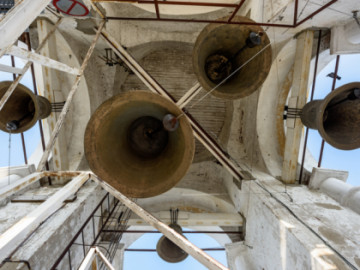
Rizopolozhenskiy Monastery
Architectural Monuments • Temples and places of worship • Abbeys and Monasteries • Other places

PUShKAR
Restaurant • Banquet room
+7 49231 23303
Payment methods:

Krasnoselskij
Restaurant • Banquet room
+7 4922 400001
Payment methods:

Vasilevsky Monastery
Architectural Monuments • Temples and places of worship • Abbeys and Monasteries • Other places
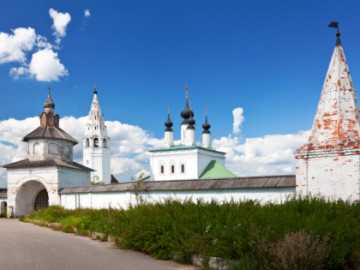
St. Alexander Monastery
Architectural Monuments • Temples and places of worship • Abbeys and Monasteries • Other places

Ogurec
Restaurant • Coffee shop • Banquet room
+7 49231 20220
Payment methods:

ULEJ
Restaurant • Banquet room
+7 49231 20901
Payment methods:

Losos i kofe
Café
+7 49231 24320
Payment methods:
